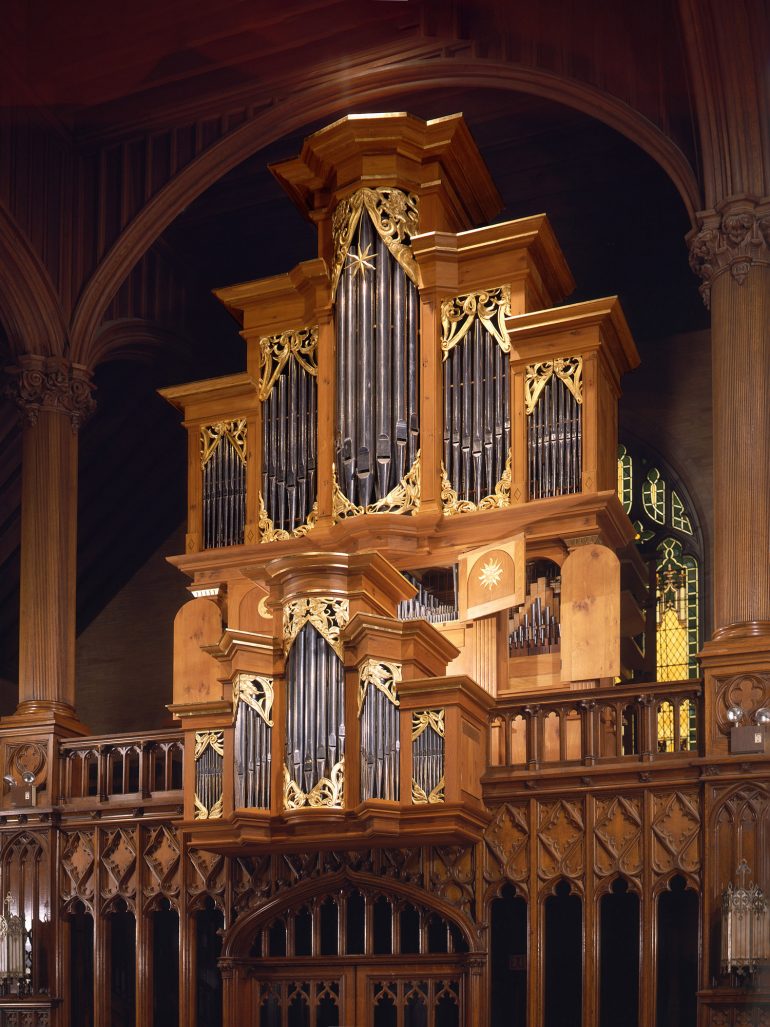
- phone: 978.283.1909
- email: cbfisk@cbfisk.com
Opus 72
Houghton Chapel, Wellesley College
Wellesley, MA
Ranks: 39Independent Voices: 28
Pipes: 1845
Created: 1981
Wellesley first signed a contract in 1972 for a two-manual organ based on antique Dutch instruments from the early 17th century. The idea of an organ of ‘uncompromising authenticity’ underwent considerable evolution over the next decade preceding its construction. From the beginning, it was intended that this specialized instrument would allow serious students of the organ to experience authentic historical European sounds. The design of the instrument would require extensive research into materials, construction methods, and voicing techniques involving hands-on experience with old instruments. College officials were aware that this unusual instrument, by offering ‘ear-opening revelations,’ would be an important contribution to the international organ scene and would draw acclaimed musicians and scholars from around the world.
Research trips taken in 1974 and 1977, organized with the help of Harald Vogel, redirected the focus of the project onto the instruments of Gottfried Fritzsche, represented in the surviving work of his son-in-law, Friedrich Stellwagen. Of particular interest was Stellwagen’s three-manual organ at the Jakobikirche in Lübeck, Germany. Measurements and observations made in the Jakobikirche and in the Compenius organ at Friedricksburg Castle in Denmark provided the raw data used to construct historically accurate key actions, wind system, windchests, and pipework. For insight into 18th century construction methods Charles Fisk and his colleagues regularly consulted Dom Bédos de Celles’ 1775 treatise L’art du facteur d’orgues.
Dr. Owen Jander, noted scholar and longtime Professor of Music at Wellesley, was the driving force behind this unique instrument. He frequently visited the workshop during the construction and was a constant source of encouragement, not only to Charles Fisk, but also to all the shop members. After the dedication he worked tirelessly to raise funds for the completion of the Pedal and Brustpedalia divisions, as well as for the hand-carved gilded pipe shades by sculptor Morgan Faulds Pike.
The organ’s casework is fumed white oak, and the façade pipes hammered burnished spotted metal, half lead and half tin. The wind pressure is 3¼” water column, and the temperament is ¼ comma meantone. The organ is equipped with two winding systems, a human-powered double wedge bellows system, and an electric blower system using one of the wedge bellows.
Opus 72 was the last organ that Charles Fisk finish-voiced before his death in 1983.
Oberwerk, Manual II
Quintadehn 16′
Principal 8′
Spillpfeife 8′
Octav 4′
Octav 2′
Rauschpfeife II
Mixture V-VI
Trommeten 8′
Rückpositiv, Manual I
Gedackt 8′
Quintadena 8′
Principal 4′
Rohrflöte 4′
Nasat 2 2⁄3′
Sesquialter II
Octav 2′
Scharff IV
Trechterregal 8′
Krummhorn 8′
Brustpositiv, Manual III
Gedackt 8′
Quintadena 4′
Waldflöte 2′
Zimbel II
Regal 8′
Schalmei 4′
Pedal
Subbass 16′
Spillpfeife 8′ (from Oberwerk)
Posaune 16′
Trommeten 8′ (from Oberwerk)
Brustpedalia
Dulcian 8′
Jungfrauenregal 4′
Cornett 2′
Bauernflöte 1′
Couplers:
RP/OW shove coupler
RP/Pedal
Accessories:
Zimbelstern
Tremulant
Indicates a double draw – this is the stop available in the half draw position.
This is the stop in the full draw postion.
Completed 1981, Pedal Posaune 16′ added 1983, carvings by Morgan Faulds Pike, 1983, Brustpedalia added 1987, case oiled and gilded 1992.
Case is antique white oak, gilt carvings in basswood.
Wind pressure: 3 1⁄4″ water column.
Manual key compasses: CC- c3, 51 notes, EH and GG are the front keys of each sub-semitone key group.
Pedal key compass: CC- d1, short octave bass, 27 notes.
Hand pump capable and electric blower supplied Tuning a1 = 440, 1⁄4 comma Meantone

